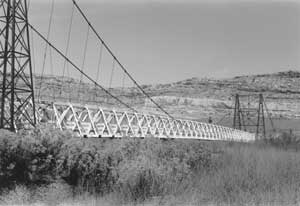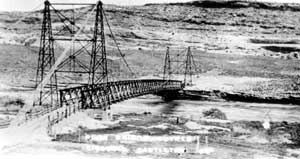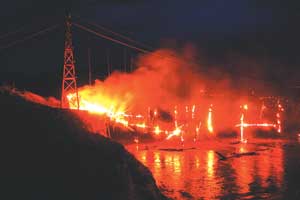 The grand dame of Utah’s bridges, the Dewey Bridge near Moab, burned down April 6 and overnight ignited a groundswell of support for reconstruction. Within days, the county received a $250 donation from a Colorado resident; a pledge of $2,500 from an old-time Moab resident; and Moab’s new museum director stepped forward to help organize fundraising, suggesting the theme: “Building Bridges In Our Community. The grand dame of Utah’s bridges, the Dewey Bridge near Moab, burned down April 6 and overnight ignited a groundswell of support for reconstruction. Within days, the county received a $250 donation from a Colorado resident; a pledge of $2,500 from an old-time Moab resident; and Moab’s new museum director stepped forward to help organize fundraising, suggesting the theme: “Building Bridges In Our Community.
Dewey Bridge, originally built in 1915 for $25,000 and dedicated April 15, 1916, had undergone reconstruction in 1998-99 and was fully restored and re-dedicated in late May 2000. It had already achieved status as a world destination with listing on the National Register of Historic Sites in 1984.
The original structure was the second-largest steel-cable suspension bridge west of the Mississippi River.
“My grandfather and grandmother (Tom and Lizzie Larsen) were there to dance on the bridge when it was first done,” recalled Bette Stanton of Moab, a member of the historical board. “They came from all over in wagons and stuff, and they danced all night on the bridge. It was a type of christening.”
“My dad (Lewis H. “Dude” Larsen) was seven years old at the time. He took cattle over it with his dad, and when they got all the cattle on it, it would swing.”
 Built by the Midland Bridge Co. of Kansas City, Missouri, in only five months, the single-lane Dewey Bridge was barely more than eight feet wide, its length-span 502 feet. It was Utah’s second-largest clear-span bridge and served as a vital crossing over the Colorado River between Moab and Cisco -- and more importantly, Grand Junction, Colo. -- until the state built a concrete, plate-and-girder bridge to serve Highway 128 traffic. The new bridge, 35 miles northeast of Moab, parallels the Dewey Bridge several hundred feet downstream. Built by the Midland Bridge Co. of Kansas City, Missouri, in only five months, the single-lane Dewey Bridge was barely more than eight feet wide, its length-span 502 feet. It was Utah’s second-largest clear-span bridge and served as a vital crossing over the Colorado River between Moab and Cisco -- and more importantly, Grand Junction, Colo. -- until the state built a concrete, plate-and-girder bridge to serve Highway 128 traffic. The new bridge, 35 miles northeast of Moab, parallels the Dewey Bridge several hundred feet downstream.
The Utah Department of Transportation decommissioned the stately old bridge and gave ownership to the county when the new 44-foot-wide bridge opened in the fall of 1988, but Dewey Bridge enjoyed an active retirement. The bridge continued serving as a cattle crossing and foot-bridge -- often enticing daredevil motorists and dirt-bikers onto its wooden planks, despite its deteriorating condition.
D.L. Taylor of Fisher Valley, who donated to the original restoration and whose ancestors ran cattle across Dewey, recalled, “Each year the bridge would get a little more shaky and the cows would get a little more frightened. You’d try to get them on there and they would get knotted up in the middle and we’d think, ‘The bridge is going to fall now.’” A member of the new restoration committee, Taylor quit using the bridge in cattle drives long ago, and likes the idea of re-erecting a lighter-weight bridge.
About the time cattle crossings ended, a new fan club developed. Mountain-biking as a recreational activity escalated in the West in the 1980s, and Dewey Bridge became a distinguished link in the Kokopelli Trail, a 142-mile bicycling route maintained by the U.S. Bureau of Land Management. It crosses backcountry from Loma, Colo. to the Slickrock Bike Trail in the Sand Flats Recreation Area east of Moab. The opening and dedication of the Kokopelli Trail link in Utah was blessed by a Hopi medicine man and his family clan in a full-costume ceremony conducted at the south side of the bridge in 1989. Bicycle groups may play a major role in its restoration.
Use of the bridge as a foot-and-bike trail, and its national status in the park system, were key elements in the original restoration fundraising effort led by Dale and Wilda Irish, charter members of the Historical Preservation Commission, which was created in 1986. Using grant funding from the state matched by generous donations and revenue from quilt sales, up- and down-street soliciting, barbecues and so on, the effort culminated with nearly $200,000 for restoration and ongoing maintenance.
Almost 92 years to the day that the original bridge was dedicated, the Irishes went out to see what remained of Dewey Bridge. “Of course, my husband and I were devastated when we heard it burned. That big old hole out there is like a grave,” Mrs. Irish said.
Dewey met its fiery demise the first Sunday in April because of a young boy playing with matches late in the afternoon at an established BLM campsite downstream, according to initial reports from authorities. The family of four tried to put out the fire, O’Hanlon said, but it was a very windy day. The blaze whipped out of control and quickly sped upstream toward the bridge, devouring dry and dense thickets of dormant tamarisk and brush and blackening cottonwood trees in its path while the family frantically tried to reach help on their cell phone, then raced to I-70 to report the fire. The wind-crazed blaze ravaged 13 acres of trees and vegetation and literally whooshed horizontally as it reached the bridge, witnesses told authorities.
 “The flame-links were, from the ground to their top height, 40 to 50 feet high,” O’Hanlon said. She described the fire as “full-on flame infringement” by the time firefighters arrived. “it was big and it was fast, and the good thing is, no one got hurt,” she said. “It literally flew across the bridge.” “The flame-links were, from the ground to their top height, 40 to 50 feet high,” O’Hanlon said. She described the fire as “full-on flame infringement” by the time firefighters arrived. “it was big and it was fast, and the good thing is, no one got hurt,” she said. “It literally flew across the bridge.”
Tausha Pruitt, dispatcher at the BLM Dispatch Center, said f irefighters from the BLM, Castle Valley and Grand County, along with six to eight engines and a BLM water tanker, raced up the river road to try to spare the bridge after the report as received at 5:08 p.m. “By the time everybody got there, it was already a lost cause,” she said. “The creosote covering it ignites fast and burns hot.”
“Dewey Bridge represents a lot more than just a pretty face or a historical presence in Grand County,” he said. “It represents the doorway -- the gateway -- to this county that many people first see as they come in. It is incredibly dramatic. People from throughout the West have commented on the sadness of losing it (and) I think that we will probably have a lot of support in restoring it.”
Editor’s note: Vicki Barker is a member of the Grand County Historical Preservation Commission. |